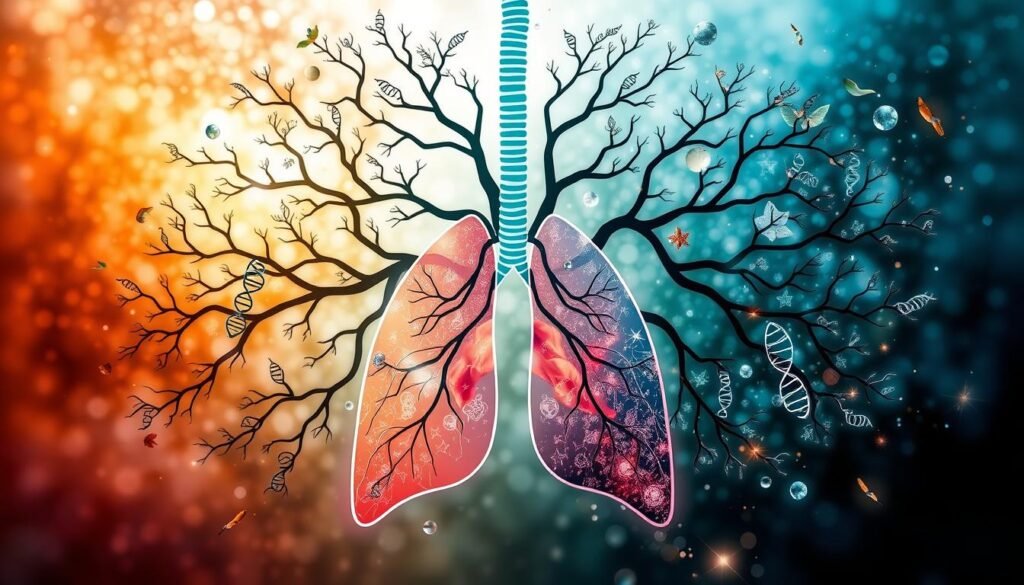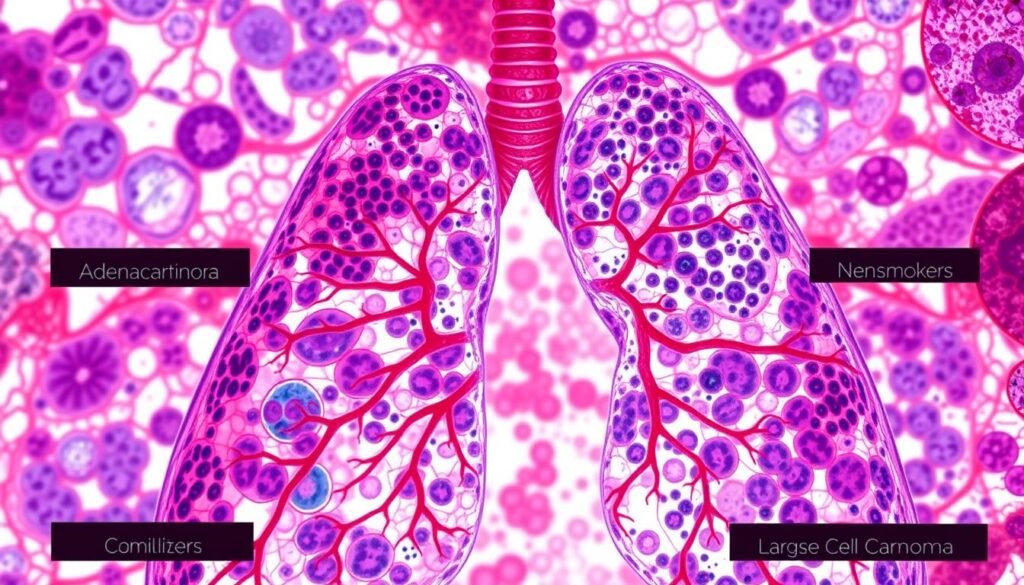It may shock you, but 15% to 20% of lung cancer cases are in people who’ve never smoked. This fact shows that not all lung cancer comes from smoking. It highlights other risk factors too. In the US, 19% of women and 9% of men with this cancer don’t smoke.
As fewer people smoke, more non-smokers are getting lung cancer. This increase makes us ask why it’s happening. A key reason is genetic predisposition, which affects risk in non-smokers. Knowing about these genetic factors helps us fight and prevent lung cancer better.
Key Takeaways
- Approximately 15-20% of lung cancer cases are found in non-smokers.
- 19% of women and 9% of men diagnosed with lung cancer in the U.S. are non-smokers.
- Genetic predisposition plays a significant role in lung cancer risk for non-smokers.
- As smoking rates decline, the number of lung cancer cases in never-smokers is increasing.
- Identifying cancer susceptibility factors is vital for prevention strategies.
Understanding Lung Cancer in Non-Smokers
Lung cancer is a big health issue, especially for non-smokers. We need to look into what lung cancer means. It’s also key to spot it in people who’ve never smoked. While many think lung cancer is mostly about smoking, there are other things at play. This includes non-smokers too.
Definition and Overview
Let’s define lung cancer in non-smokers. It’s when lung cells grow out of control. This can happen because of radon, polluted air, or secondhand smoke. Studies show that non-smokers get a chunk of lung cancer cases. They often get it differently and younger.
Specific genetic changes, like CHEK2 and EGFR mutations, play a role. This is different from what’s seen in smokers. That’s why we need to pay attention to lung cancer in non-smokers too.
Importance of Recognizing Non-Smoking Cases
It’s very important to know when non-smokers have lung cancer. This helps with awareness and finding the right treatment. Many people don’t know that not just smokers get lung cancer. There are environmental and genetic reasons too.
When we know this, doctors can help patients better. Everyone can then understand lung cancer better. This leads to the right tests for those at risk, smoking or not.
Genetic Predisposition and Its Role in Lung Cancer for Non-Smokers
Lung cancer is a big risk even if you don’t smoke. This is due to genetic factors. Figuring out these factors helps in finding the right treatments.
Key Gene Mutations Linked to Lung Cancer
Research has found important genetic mutations related to lung cancer in non-smokers. The EGFR mutation is a key example. Researchers have identified 2910 genetic variants in 754 genes. Of these, 22 variants in 21 genes are strongly linked to lung cancer in non-smokers. These findings show how important genetic testing is for personalized treatment.
Hereditary Factors Influencing Lung Cancer Risk
Genes you inherit can affect your lung cancer risk, even if you’ve never smoked. Mutations in genes like CHEK2, TP53, and BRCA1 play a role. This information is crucial for screening people at risk. It shows that knowing your family’s health history can help in finding and treating lung cancer early. You can find more details on these studies here.
Environmental Exposure and Its Interaction with Genetics
Environmental factors are key in the risk of lung cancer for non-smokers. Things in our surroundings, like various carcinogens, can push lung cancer risks higher, especially if you’re genetically predisposed. The mix of these elements and our genes point out important risk factors for lung cancer.
Common Environmental Carcinogens
Many things around us can increase lung cancer risk. Here are some top ones:
- Radon: A radioactive gas found naturally. It can build up in homes and raise lung cancer risk.
- Asbestos: Used in buildings, linked to lung cancer and other diseases, especially in workers.
- Formaldehyde: In household products, long-term exposure can cause cancer and other health issues.
- Outdoor air pollution: Full of cancer-causing stuff. It ups the risk of lung cancer and other illnesses.
The Role of Air Pollution in Lung Cancer Development
Air pollution greatly affects non-smokers’ lung cancer risks. Studies show that tiny particles and pollutants might work with genes to up cancer risks. If you live in a city with lots of pollution, your chances might be higher.
Many research studies link air pollution tightly with lung cancer. Knowing how air quality affects cancer is key for public health efforts. With better awareness and new policies, we can lower air pollution exposure and its lung cancer risks.
Familial Patterns and Lung Cancer Risk
Looking into lung cancer’s familial patterns, we find clues about the disease being inherited. Studies show a pattern where lung cancer cases cluster in families. This suggests a genetic role in the illness, especially for those who don’t smoke.
This knowledge boosts awareness. It also shows the need for more research on genetics in people at risk.
Familial Aggregation of Lung Cancer Cases
Studies on lung cancer clustering found that relatives of lung cancer patients are more likely to get the disease. This holds true even if they’ve never smoked. Research reveals that having a first-degree relative with lung cancer raises your risk.
This risk increases with more affected family members or if the cancer was found early in life.
Studies Showing Genetic Patterns in Families
Deep genetic analysis has unveiled patterns of predisposition within families. An analysis of patients with non-small cell lung cancer (NSCLC) showed many had relatives with cancer. In fact, 71% had a family history of cancer, while 14.9% had harmful genetic variants.
Genes like BRCA2, CHEK2, and TP53 are linked to a higher lung cancer risk. This highlights the urgency for ongoing study into these familial patterns. This will help improve screening and treatment for those with a genetic risk.
For more on lung health, check an informative resource about lung cancer risk and allergies.

Distinct Molecular Pathways in Non-Smoker Lung Cancer
Lung cancer in non-smokers is different from that in smokers. It involves complex molecular pathways. Specific mutations, such as in the tumor protein p53 and epidermal growth factor receptor, are often found changed in non-smokers with lung adenocarcinoma. Knowing about these pathways helps us understand how tumors form in non-smokers.
A study looked at 501 lung adenocarcinoma patients; 210 were non-smokers. This shows why it’s important to study non-smokers’ unique molecular features separately. Scientists found 231 genes that behaved differently in non-smokers, with some more active and others less so. A method called Gene Set Variation Analysis revealed 42 crucial pathways in non-smoker lung cancer.
Looking at immune cells showed differences between non-smokers and smokers. For example, non-smokers had more active CD8+ T cells. Researchers also discovered important interactions between certain genes and miRNAs, hinting at complex regulation. Such findings may lead to new treatments.
Analyzing certain genes like neurotensin, neuronatin, and trefoil factor family 2 backed up these insights. They showed the same trends in several studies. This information lays a strong foundation for future research. It aims at finding specific treatments for lung cancer in non-smokers, which could greatly help this group.
Histological Differences in Lung Cancer Among Smokers and Non-Smokers
Lung cancer looks different in smokers compared to non-smokers. These differences are key to figuring out prognosis and treatment options. Studies show adenocarcinoma is more common in non-smokers. In contrast, smokers often have squamous cell carcinoma. The lung cancer comparison highlights the need for treatments based on each patient’s unique situation.
Adenocarcinoma vs. Other Histological Types
Adenocarcinoma is mainly found in people who’ve never smoked, especially in East Asia. Around 70% of these patients have EGFR mutations that respond well to specific drugs. This pushes the focus towards adenocarcinoma in non-smokers. It stresses the need for different lung cancer therapies than those for smokers’ lung cancers.
Impact on Treatment Decisions
The type of lung cancer plays a big role in choosing treatments. Doctors look at the cancer’s histology to pick the best therapy. Non-smokers with adenocarcinoma might benefit more from certain treatments. These may not work as well for squamous cell carcinoma found in smokers. This difference underlines the value of tailoring lung cancer treatment for each patient. For more details, see studies on histological types and treatment options.

| Histological Type | Prevalence in Smokers | Prevalence in Non-Smokers | Common Treatments |
|---|---|---|---|
| Squamous Cell Carcinoma | High | Low | Chemotherapy, Radiation Therapy |
| Adenocarcinoma | Moderate | High | Targeted Therapy, Immunotherapy |
| Large Cell Carcinoma | Low | Low | Chemotherapy |
Importance of Genetic Testing in Non-Smokers
Genetic testing is key in fighting lung cancer for non-smokers. It helps doctors make better treatment choices. Genetic testing finds inherited changes that show if you’re at risk, and spots mutations for targeted therapy.
Understanding Germline and Somatic Mutations
Germline mutations are in all your cells from birth, passed down from your parents. They may raise your cancer risk. Somatic mutations happen during your life and aren’t passed down. Both are crucial for understanding lung cancer in non-smokers, who might not have common risk factors.
Benefits of Early Detection through Genetic Profiling
Finding mutations early is key to better lung cancer outcomes. Genetic profiling spots these early, leading to timely and life-saving treatments. It’s vital, as non-smokers may need different treatments than smokers. Knowing your genetic risks helps in crafting your treatment plan and keeping an eye on the disease.
Preventive Measures for Those at Genetic Risk
People with a high genetic risk for lung cancer need to be proactive. This is especially true for non-smokers. Getting regular screenings can catch problems early and improve health outcomes.
Your risk for lung cancer can depend on your family history and genetics. It’s important to know these factors.
Screening Guidelines for High-Risk Individuals
If you’re likely to get lung cancer due to genetics, screening is key. The type of screening you need depends on your specific risk. General advice includes:
- Annual low-dose computed tomography (LDCT) for individuals aged 50 and older with a history of high risk.
- Regular assessment of lung health in individuals with a family history of lung cancer.
- Consideration of genetic counseling for those with identified mutations linked to lung cancer.
Lifestyle Changes to Mitigate Risk
Making lifestyle changes is also important for lung cancer prevention. Small changes can make a big difference. These changes include:
- Adopting a balanced diet rich in fruits and vegetables, particularly those high in antioxidants.
- Engaging in regular physical activity to maintain a healthy weight.
- Avoiding exposure to known carcinogens, including radon, secondhand smoke, and occupational hazards.
- Ensuring good indoor air quality and minimizing pollution exposure.

By following screening guidelines and making lifestyle tweaks, you can fight lung cancer. This approach boosts your overall health too.
| Preventive Measure | Description |
|---|---|
| Screening with LDCT | Annual low-dose CT scans for early detection. |
| Dietary Changes | Increasing antioxidant-rich foods to reduce cancer risk. |
| Physical Activity | Regular exercise to maintain a healthy lifestyle. |
| Avoiding Carcinogens | Staying away from known harmful substances. |
Recent Advancements in Research and Treatment
Lung cancer research has made significant strides lately. It’s now focusing on new treatment methods that effectively target genetic mutations found in non-smokers. Among these, targeted therapies like EGFR inhibitors play a critical role. They bring a new hope to those at genetic risk by addressing specific mutations.
Targeted Therapies for Genetic Mutations
Targeted therapies are at the forefront of lung cancer management for patients with certain genetic mutations. Up to 76% of non-smoking lung cancer patients have oncogenic driver mutations. These mutations vary across ethnic groups. For example, Caucasians have a range of EGFR mutations. This highlights the need for treatments tailored to each patient. Indeed, advancements in genetic testing are crucial for these personalized treatments.
Future Directions in Lung Cancer Treatment
The future of lung cancer research is about making treatments more personal. Researchers are combining targeted therapies with immunotherapy. This technique uses the body’s immune system to fight cancer. Understanding lung cancer’s unique biology in non-smokers is key to this approach. It could lead to treatments that greatly improve patient lives.
Looking ahead, combining treatment innovations with genetic breakthroughs is promising for lung cancer care. There’s an urgent need for better prevention and treatments that consider genetics and environmental risks. Recognizing risks like secondhand smoke and indoor pollution is critical for effective lung cancer management.
Non-smokers account for a large group of lung cancer patients. Targeting treatments for them is crucial. This approach aims to not just increase treatment success but also bring hope to many facing this disease. For more on these advancements, visit MDPI.
Conclusion
Researchers and healthcare workers are diving deep into how genes affect lung cancer risk in non-smokers. They’ve found that 10-15% of lung cancers in the West are in people who’ve never smoked. This shows we need to pay more attention and study these cases more.
Having a family member who’s had lung cancer can make your own risk go up by 50%. This is even when you don’t consider other risks. A study from the Nordic countries found that genes might be behind 18% of lung cancer cases in non-smokers.
Some genetic problems, like Li-Fraumeni syndrome, can make it more likely for someone to get lung cancer. These findings help doctors treat patients more personally. They tailor care to each person, which can lead to better health results.
To wrap up, the latest research shows us how complicated lung cancer is in non-smokers. It highlights the need for detailed cancer screenings and genetic tests. Scientists are working hard to understand all this better.
This effort is crucial. It helps in finding ways to prevent and treat lung cancer in everyone. Our goal is to beat this tough health issue through deep knowledge and innovative treatments.